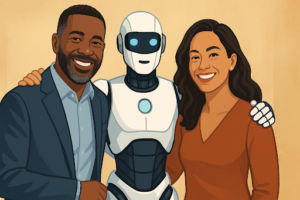Will Someone Answer the Phone?!
The unknown call to a landline has become as undesirable as the unexpected knock on our door from an activist seeking signatures on a petition, a religious zealot seeking to inform you about your salvation or a local candidate seeking your vote.
If you’re among the roughly half of the population who still has a landline phone, think about your reaction when it rings these days. As cellphones have replaced the landline as the ubiquitous device in our lives, calls to landlines have become more inconvenient. Before the distinction of landline vs. cellphone years ago, most of us accepted the necessity of getting up and answering our home phone. But, things have changed.
Many of us carry our cellphones or have them nearby, so checking to see if it’s a call we want to take is easy. But, landlines usually require us to get up and go to the phone, sometimes adding the step of finding a cordless handset buried in a couch, then looking at the caller ID and finally determining if it’s a call we want to take from perhaps a child or older parent or a friend. In other words, the call to a landline phone is always an interruption – and a call from an unknown number is always an unwanted interruption.
If you’re among the declining percentage who’ll even answer the unknown call to a landline nowadays, think about your tone when you answer and compare it to how many of us were trained in “phone etiquette” by our parents. No longer a courteous greeting, the way we answer an unknown call to a landline is now bathed in suspicion. A flat, “Yes” or “Hello” is about as good as it gets. Our “greeting” is now bathed in the fact that the call is an unwanted intrusion. While some of the call center agents at the other end are trained to handle suspicion and displeasure, the interaction starts from a poor position.
Now, what if the call is on your behalf from a telemarketing agent trying to convince the consumer to listen to your radio station or play a contest on your station? While you’ll be able to measure the number of connections made, what’s the quality of the engagement? What’s the larger impression left with the consumer from the exchange? Unwanted calls now commonly earn consumer scorn and businesses can be stained by that scorn.
While we may have to interrupt the consumer to get them to pay attention to a radio station they don’t know, there are other places and other ways we can access them in a less destructive manner today. We can use paid positions in Facebook and other social media channels to get outside the station’s existing base, but use the power of big data to target only the best prospects and also tailor the message to maximize the likelihood of success. We can use the power of internet advertising to chase the most-desirable consumers around the internet with high frequency. We can use big data to first identify only the specific homes to which we want to send mail and then use big data again to customize each piece to maximize the likelihood that it will get the recipient’s attention.
What if the call is on your behalf from a call center agent asking the consumer to rate some music hooks or answer questions about their radio listening preferences? After sufficient expensive hours with the call center, you’ll have completed enough interviews, but again, what’s the quality of the engagement? Do we really want to rely on the opinions of consumers who’ve been hoodwinked into answering “just a few more questions” while they’re really trying to get back to whatever they were doing before the phone rang? When that was the only way to engage consumers, it had to be good enough. When that was the only way ratings participants were obtained, it was good enough.
Online samples, properly recruited and screened – and not opt-ins from station outreach or station database or crowdsourced – allow us to engage consumers when it’s convenient for them. They answer our questions and give us their opinions knowing how long it’s going to take, so they’re in control. And, they get paid for their time, just like people who participate in the ratings. We benefit because they’re more engaged and because they’re more likely to represent the opinions of people who engage in the ratings.
Q: A duck can fly 40 miles an hour; with a headwind of 50 miles per hour, how long will it take the duck to fly 100 miles?
A: A little over an hour if he flies with the wind.
The world has changed and it’s in our best interest to change with it. While budgets get tighter and tighter and smart managers find new and better ways to do things. What will you do differently for 2015?




